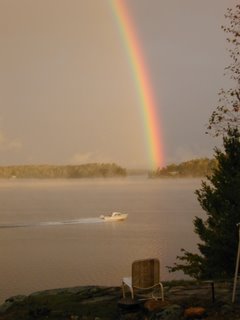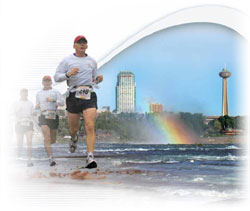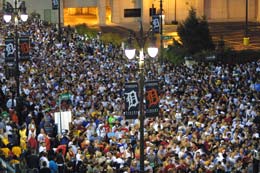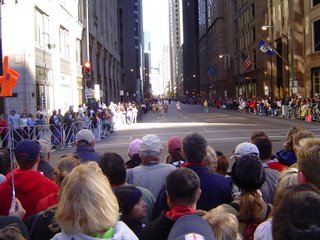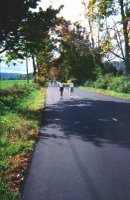
On the Road to Corning, New York – The 25th Wineglass Marathon
In early June I had to make up my mind…would I do another marathon, and if I did, would I sign up for another Running Room Marathon Training Clinic. My 50th birthday was looming on the horizon in mid-October…so a summer/fall training program would be required if I was going to get complete another race in the “under 50” age group.
The decision to do another marathon was a very easy decision for me to make…my wife Megan has just added triathlons to her running program and was gearing up her training for Ironman Canada in Penticton next August. Long distance running provides us with a common pursuit that we can do together and it lets us share a network of friends.
The decision to train with the Oakville Running Room’s Marathon Clinic, led by Dave Howlett, was a no-brainer…Dave’s coaching and the support from other clinic team members were key in helping me complete my first marathon last October, the Royal Victoria Marathon (4:39:19)…and helped me to improve my performance in my second marathon, the Mississauga Marathon in May (4:19:37).
So then it was just a matter of which race to run. Megan put me on to the Wineglass Marathon in Corning, NY. It’s a day’s drive from Oakville, a relatively flat course, and we both know runners who have completed the marathon and had great things to say about it. The added advantage was that it was on October 1st, so I would be able to get my race in early in the fall before I set off on a number of business-related trips abroad.
Diane Gordon was the 3:59:59 Training Group lead for the clinic. She did a great job of creating and fostering a sense of “team” for our group. Her weekly emails and the exchange of emails with other 3:59:59 runners helped me stay motivated throughout the training schedule…including the days when I was off on vacation. Diane’s stories of her own experience running the Wineglass Marathon combined a fun atmosphere with her own personal best race result.
Corning is a picture postcard small town in upstate NY, with a gently sloping downhill racecourse that winds its way through farmland, small rural towns, and along the Chemung River to finish at the Corning Museum of Glass in downtown Corning. But Corning is also a long way from Oakville…so I was mindful that I didn’t leave any of my race-day gear behind. I found the “Dave Howlett 2 week count-down checklist” to be very helpful. It forces you to think about things that are very easy to overlook when you’re running a race that involves travel away from where you live…a must read for all this year’s clinic members headed for Detroit!
Race day was about as good as it gets…57 F (~14 C), low overcast, and light winds. The forecast for the day called for rain and thunderstorms…but neither materialized. From the 9:00 a.m. start gun right through to the finish I stuck to my race day plan. Throughout my training schedule I had maintained at least 75% of the weekly target mileage and 100% of the scheduled long distance training runs, so I was very comfortable with my level of fitness and my pace. Throughout the clinic the need for proper hydration and carb replacement had been drilled into me…so my fuel belt was primed and ready to go – Gatorade; gels and sports beans. Pavlov would have been proud…my weekly long training runs conditioned me to anticipate the beeping of my Garmin to signal the start or finish of my “10 and 1’s”. For me, 10 and 1’s are the key to being able to improve my performance. I can push harder for 10 minutes knowing that I’ve got a minute walk break in which to recover. I had my pace band printed off in Miles (using the Running Room website) - - because with the exception of the 20 km and 40 km markers, all of the distance markers for a U.S.-based race are all in miles.
Early in the race I was fortunate to draft in behind a group of 6 runners who were targeting a 4-hour finish. They all looked to be in great physical shape and they ran with confidence and an easy gait…and they ran without using the “10 and 1’s” that I was using. Each time that I was about to catch up to them it seemed that my Garmin would chime to let me know that I had earned another minute of recovery…and I would watch as they ran away from me. This routine of “almost catch them and then retreat” went on until a short uphill pitch at mile 21 where I passed 5 of these 6 runners. I fully expected them to overtake me on my next 1-minute walk break…but I didn’t see those 5 again until they finished several minutes behind me. This real-life example reinforced the benefits of 10 and 1’s for me…provided you stick with them throughout the race. They aren’t just a training tactic that you discard or shortcut on race day.
I couldn’t have hoped for a better race. I ran past the 13.1 mile marker (1/2 way point) right on pace - - 1:59:26 and I felt good and in control. Shortly after that point, the low overcast clouds gave way to sunshine and blues skies…with the result that the temperature bumped up into the low 70’s. The warmer temperature combined with a few rolling hills in the last 5 miles of the course caused me to slow my pace slightly. But it was still a comfortable pace and I felt good. Megan was on her bike and provided “curb crew” support a various points during the final 13.1 miles. In addition to the physical support of providing reloaded water bottles and gels, the mental support of seeing her cheering me on and providing positive encouragement was huge! There were a couple of rough spots where I was grinding it out and looked up to see her ahead on the curb that helped me to redouble my efforts to keep going.
And then it was down to the final 1.1 miles…I could see the finish area and knew that it was just a case of staying focused. I was tired and slowing down, but I was going to run my race pace to the finish. I crossed the finish line at 4:08:19…and while I have saved the fun of joining the 3:59:59 club for a future race, I was absolutely delighted with my race. I had achieved my objectives: I had fun; I finished; I didn’t get injured; I improved my results (new PB!), and I met a bunch of fun new people in life. Not bad for 4 hours work! (OK…4:08:19 hours work!).
But it really isn’t about 4 hours (or 3 hours or 5 hours) work…it’s all about the process that begins the minute you make the commitment to do the clinic and to run a race. Its about the kilometers that you put in with your running group; and the fantastic spectator and volunteers at every race; and the emails that Dave sends on a weekly basis; and the stories that get told (and retold) over a cup of coffee at Second Cup after a training session; and your neighbor and running clinic buddy, Jo Sharlan, dropping by the night before to wish you luck; and the phone call from Dave and his wife Barb wishing you well in your race tomorrow. This has to be one of the ultimate “team” sports!
I’m already planning for my next race and my next clinic. I’ve vowed to myself to be 5 pounds lighter and to concentrate on speed work and stretching during my next training program…and to find ways to give back some of the support that I’ve been fortunate enough to receive over my brief running career.
See you on the road!
Blake
